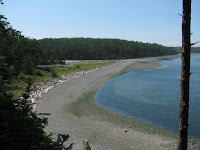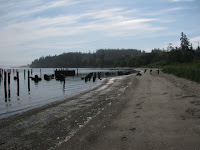




The University of Washington's Friday Harbor Laboratory has been perched here on the point north of the town for most of the last century. The research focus was historically more on marine biology and rocky coastlines than on beaches, which makes sense given its location.
The lab, like other water-oriented developments, has grown somewhat organically along the edge of the water - with the interest clearly more in getting to the water or using the water (the labs thrive on a lifeblood of circulating salt water) than in the shoreline itself. I found the waterfront a little ragged with its crumbling stone walls, its collapsing piles of riprap, and its abundance of pipes.
It might be interesting to look at historical photos of the lab's shoreline. I wouldn't expect too much natural change, although I saw some evidence that the beaches (limited as they are) may be continuing to erode. They would have done so anyways, plus any material that would have originally eroded from the banks to resupply them is safely secured behind all the riprap!
But it's sure a neat place to have a meeting! It's not exactly convenient, but it's a far more pleasant venue that an interior conference room in an office building in Olympia.























